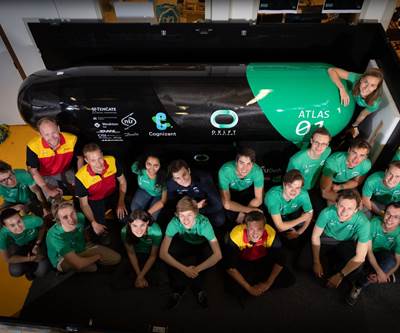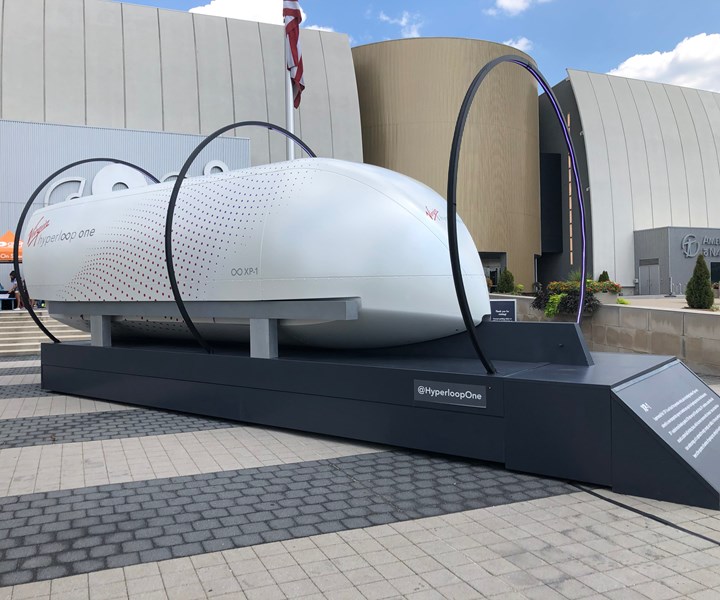
Virgin Hyperloop One’s XP-1 test pod on display at COSI (Columbus, Ohio, U.S.). CW Photo | Scott Francis
Since SpaceX (Hawthorne, Calif., U.S.) founder and CEO Elon Musk published his Hyperloop Alpha white paper in 2013, the concept of a Hyperloop system has captured the imagination of the public as a possible mode of transportation. Meant to compete with commercial continental air travel between cities separated by approximately 900 miles or less, the concept envisions use of a capsule — also called a “pod” — to transport passengers and freight at high speeds through a tube or series of tubes. The tubes are designed to reduce air resistance using a partial vacuum; the pods, either magnetically levitated or running on air casters, enjoy a nearly frictionless environment and can, theoretically, reach speeds of 600–760 mph (965-1200 km/hr.).
Musk’s Hyperloop concept was released as an open-source design meant to encourage others to build upon the ideas and further develop this transportation system. The concept has inspired several commercial companies and student teams to create Hyperloop prototypes, which are in various stages of development and testing. Virgin Hyperloop One (VHO, Los Angeles, Calif., U.S.) has built a test pod as well as a full-scale Hyperloop test track and has completed hundreds of test runs to date. The company has yet to develop a pod that can accommodate passengers. Meanwhile, Hyperloop Transportation Technologies (HyperloopTT, Culver City, Calif., U.S.) boasts the first full-scale Hyperloop passenger vessel and a 320-meter test track in Toulouse, France.
Although the Hyperloop concept evokes comparisons to traditional rail-based modes of mass transit, because of the low air pressure and high speeds involved, Hyperloop pods actually have more in common with aircraft fuselages. Traveling in a Hyperloop tunnel exposes the pods to speeds and air pressure conditions similar to those of an aircraft traveling at an altitude of around 200,000 feet. To handle the demanding loads, high speeds and internal pressures, the pods require materials that combine stiffness and strength with light weight. Most of the Hyperloop prototype vehicles developed to date have employed carbon fiber composites in some way.
“With the lightweight needs [of the Hyperloop], the solution will be composites,” says John Jackson, technical support engineer for Toray Advanced Composites (Langley Mill, Nottingham, U.K.). “With the demand we are experiencing from Airbus and Boeing for structural thermoplastics, and the general aerospace market trend for OOA [out-of-autoclave] and automated thermoplastics, we foresee this being reflected in the development of the Hyperloop pods.”
A built-in proving ground
SpaceX has continued to support Hyperloop through its Hyperloop Pod competition, which has been held annually at the company’s Hyperloop test track in Hawthorne, Calif., U.S., since its inception in 2015. The competition gives teams the opportunity to compete with a subscale prototype Hyperloop vehicle to demonstrate the concept’s feasibility. Judging criteria take into account design, pod requirements and safety for the qualifying rounds. Qualifying pods are raced in the main competition. In the past, sub-competitions have been part of the event, focusing on aspects such as levitation, but the most recent competition focused on top speed alone.
In 2019, SpaceX held its fourth Hyperloop Pod competition. Twenty-one teams were selected to compete, with four qualifying for the final round on July 21 — Swissloop of ETH Zürich (Zürich, Switzerland), EPFLoop of Ecole polytechnique fédérale de Lausanne (Lausanne, Switzerland), Delft Hyperloop of Delft University of Technology (Delft, Netherlands), and TUM Hyperloop of the Technical University of Munich (TUM, Munich, Germany). TUM Hyperloop, formerly known as WARR Hyperloop, won the competition, setting a new record with a top speed of 463 km/hr. (288 mph). The team might have further exceeded the record speed, but its pod suffered damage due to derailment of one of its propulsion modules, and was forced to brake early.
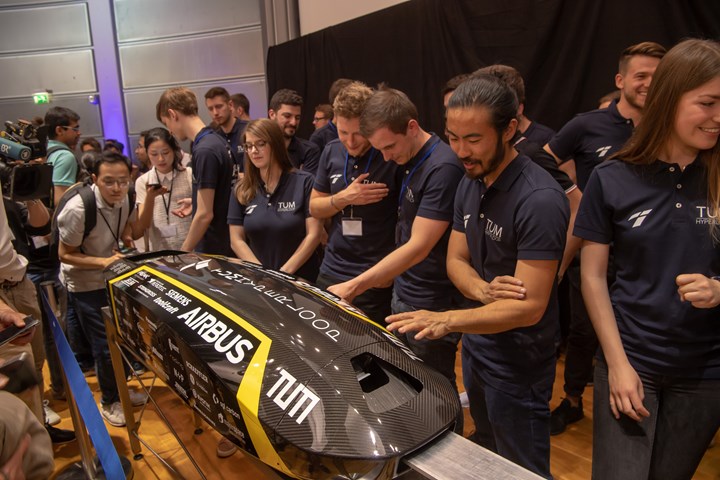
TUM Hyperloop won SpaceX’s 2019 Hyperloop Pod Competition in July, setting a new record with a top speed of 463 km/hr. (288 mph). Source | TUM Hyperloop
TUM Hyperloop constructed its pod using carbon fiber prepregs from SGL Carbon (Wiesbaden, Germany). Based on design and material optimizations, the carbon fiber shell of the current pod weighs around 10% less than that of the team’s previous model (5.6 kilograms compared to 6.1 kilograms).
“We have replaced some parts that used to be made of plastic with carbon,” says Paloma García Guillen from the TUM team. “This has made the shell around a kilo lighter, but at the same time extremely stable to withstand the high pressure and centrifugal forces in the tube.”
“It’s impressive to see what the [TUM team] achieved in such a short amount of time,” says Dr. Christoph Ebel, head of the Lightweight and Application Center at SGL Carbon. “From the idea, to prototype development, to the finished part, the team only needed a few months. Behind the Hyperloop pod design are numerous innovative ideas based on modern lightweight construction, challenging to realize technologically.”
The Hyperloop Pod competition helps foster constant redesign and innovation. The teams rework their pod designs each year and receive support from material suppliers and technology companies.
Swissloop’s second-place pod — the Claude Nicollier, named after the first Swiss astronaut — is run by a linear induction motor that itself prompted an innovation award from SpaceX. The pod’s chassis comprises carbon fiber, resulting in a total weight of only 200 kilograms.
EPFLoop’s prototype, the Bella Lui, features a U-shaped carbon fiber skeleton with the motor on the inside and battery packs on the outside. A small pressurized chamber on top of the pod protects the electronic components and the entire pod is covered in a carbon fiber skin. According to team leader Lorenzo Benedetti, EPFLoop used biaxial prepregs XC411 and RC200 from Gurit (Wattwil, Switzerland), as well as the company’s M80 and M200 foam cores.
Delft Hyperloop ’s Atlas 02 pod comprises a full composite chassis and carbon fiber battery case. The vehicle was manufactured with automated tape laying (ATL) technology and support from Airborne (The Hague, Netherlands) using Toray Advanced Composites’ uni-directional carbon fiber epoxy-based prepregs.
Each year of the Hyperloop Competition, the pods get faster and set new records, but reaching the 600-700 mph speeds that Hyperloop promises has yet to be accomplished. The consensus is that longer tracks are needed in order for the pods to reach top speed. SpaceX’s current track is approximately one mile long, but following the July 2019 competition, SpaceX announced plans to build a new Hyperloop track to be used for the 2020 pod competition. According to a Tweet from Musk, the new tunnel will be 10 kilometers (roughly 6 miles) long and will include a curve.
Passenger pods
Among the commercial Hyperloop companies working to develop passenger pods, set up test tracks and garner support for proposed routes, VHO and HyperloopTT are arguably the two leaders , with TransPod (Toronto, Canada) also in the running.
VHO’s Hyperloop uses electric propulsion to gradually accelerate pods. A propriety magnetic levitation system allows them to glide at aircraft speeds through low-pressure tubes. VHO’s test pod, the XP-1, is constructed of a structural aluminum chassis surrounded by a carbon fiber shell. The test vehicle, which is not designed for passenger use, has achieved speeds of up to 240 mph on VHO’s 500-meter test track, known as DevLoop (Las Vegas, Nev., U.S.).
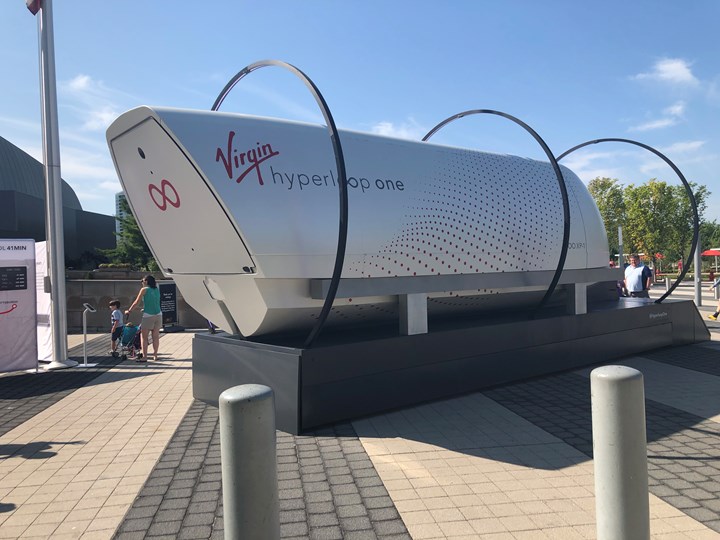
VHO’s test pod, the XP-1, is constructed from structural aluminum and a carbon fiber shell. CW Photo | Scott Francis
According to Ryan Kelly, marketing manager for VHO, the design of the company’s Hyperloop pod was approached much like that of an airplane fuselage. The stress of loads, extreme speeds and internal air pressure all have to be taken into account for vehicle design and materials selection. While VHO has not yet developed a passenger pod, Kelly expects that composites will play a role in the design, just as they have in the test pod.
HyperloopTT boasts the first full-scale Hyperloop passenger vessel. The pod, Quintero One, is constructed almost completely out of a composite material HyperloopTT calls Vibranium (a nod to the fictional material conceived by Marvel Comics for Captain America’s iconic shield). The material is, in fact, a specially made dual-layer smart composite material created using carbon fiber and embedded sensors. HyperloopTT’s 32-meter-long capsule is made up of 82 carbon fiber composite panels. It was built at the aerospace facilities of HyperloopTT’s partner Airtificial (Madrid, Spain), a company that specializes in the design, engineering and manufacturing of sensor-enabled structures made of composite materials. Airtificial was formed by the merger of Carbures (El Puerto de Santa María, Spain), a composite structures manufacturer for the transportation and infrastructure sectors, and civil engineering company Inypsa (Madrid, Spain) in 2018.
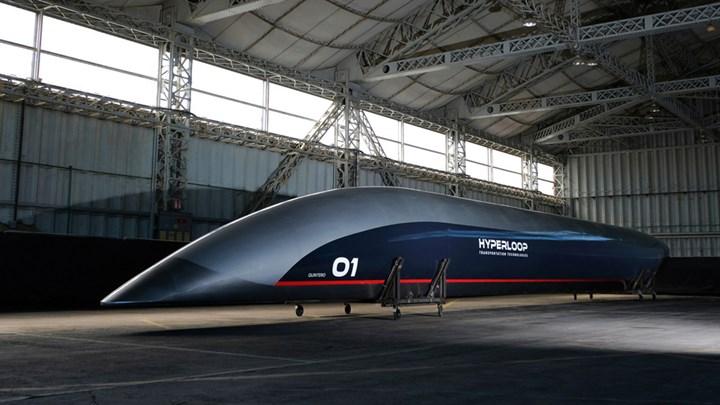
HyperloopTT’s passenger capsule features a proprietary dual-layer smart composite material created using carbon fiber and embedded sensors. Source | Hyperloop Transport Technologies
Like VHO’s XP-1, TransPod’s vehicle design is also similar to an airline jet fuselage and is driven by magnetic propulsion. The passenger pod structure and shell are being co-developed by Blackshape Aircraft (Monopoli, Italy), which produces carbon fiber composite aircraft for the general aviation sector.
“Composites form certain parts (but not all) of the structure,” says Ryan Janzen, co-founder and chief technical officer of TransPod. “It’s all about being strategic with the different materials.”
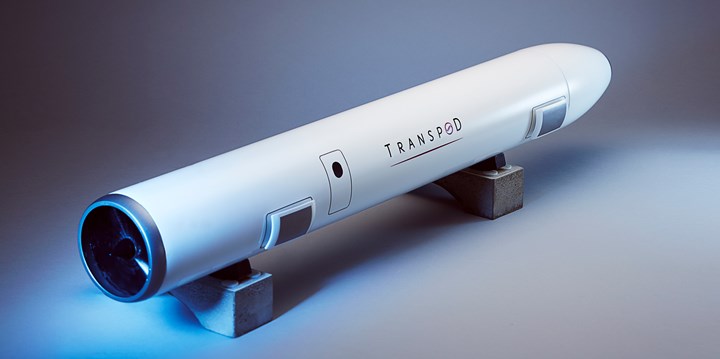
TransPod is working with carbon fiber aircraft manufacturer Blackshape Aircraft to develop its passenger pod. Source | TransPod
Hyperloop infrastructure
In addition to the pods, there is also potential for composites use in the Hyperloop tubes themselves. Composites are, of course, lighter than traditional materials but still able to meet structural requirements, but they are also less susceptible to the elements. While weather conditions could potentially compromise the structural integrity of a steel or concrete tube over a period of time, a composite tube is less likely to suffer problems caused by thermal expansion or corrosion. Many of the existing Hyperloop test tracks have, for the most part, been built of either steel or concrete, but there are companies exploring the use of advanced materials.
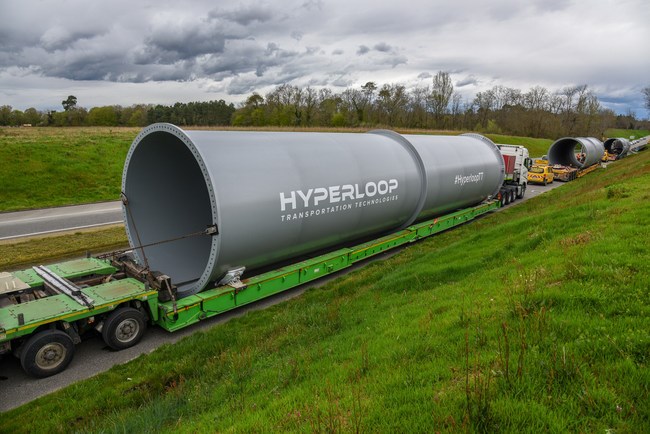
HyperloopTT’s tubes are a combination of steel, concrete and carbon fiber. Source | Hyperloop Transportation Technologies
HyperloopTT’s tubes, like its passenger capsule, are manufactured by Airtificial and are a combination of steel, concrete and sensor-embedded carbon fiber. In 2018, Airtificial signed a contract for €19.9 million with HyperloopTT to manufacture a 5-kilometer pilot section of Hyperloop tube. Tube manufacturing and installation will be done after completion of analysis of tube prototypes installed at HyperloopTT’s research facilities in Toulouse, France.
Composites play a role in TransPod’s tube design as well: “The TransPod infrastructure includes a tube, and many other materials inside and outside the tube segments,” says Janzen. “The materials include metals, polymers and some composites. All of these parts work together to manage the loads, dynamics, pressures and propulsion forces.”
Meanwhile, Delft Hyperloop and Jules Dock (Rotterdam, Netherlands), a developer and manufacturer of a range of composite products, are collaborating on research for composite tubes based on a concept Jules Dock is working on for offshore wind turbine towers manufactured via continuous filament winding (CFW). Delft Hyperloop and Jules Dock stated on the blog Hyperloop Connected that filament winding might enable pop-up factories to produce the composite tubes on-site as Hyperloop routes are built.
Commercial Hyperloop
While development of test pods and tracks is underway, Hyperloop companies are working with governments, partners and investors to drum up funding and support for proposed routes in the U.S. and around the world.
VHO plans to begin work in December 2019 on a 15-kilometer test track in India for a Mumbai – Pune Hyperloop route aimed at reducing drive time between the cities from 3-4 hours (including traffic) to 25 minutes. The company has also announced plans to conduct a study of a potential Hyperloop test track in Saudi Arabia. According to VHO, the study will focus on King Abdullah Economic City (KAEC), located 100 kilometers north of the Red Sea port of Jeddah. The proposed project includes a 35-kilometer test track and will create opportunities for the development of Hyperloop technologies and expertise in the region.
In the U.S., Hyperloop companies hope to build on the momentum of U.S. Secretary of Transportation Elaine Chao’s Non-Traditional and Emerging Transportation Technology (NETT) Council. NETT was launched at the South by Southwest Conference (SXSW, Austin, Texas, U.S.) in March 2019 and aims to support new and innovative transportation projects like Hyperloops and autonomous vehicles.
VHO is conducting feasibility studies and environmental impact studies (EIS) for numerous U.S. routes, with its eye on a Chicago, Ill.-Columbus, Ohio-Pittsburgh, Pa. corridor in the Midwest, a St. Louis-Kansas City route in Missouri, and a Dallas-Fort Worth corridor in Texas. The company visited Capitol Hill in Washington D.C. in June 2019 to present its technology to members of Congress and federal stakeholders. In August, VHO launched a roadshow across the U.S., with stops in Missouri, Texas and Ohio, showcasing its XP-1 test pod in an effort to connect with communities, and to educate local and state governments on how Hyperloop can help advance the country’s transportation capabilities.
“We are now seeing the groundswell of support that’s needed to realize the Hyperloop revolution with the formation of the NETT Council and support from lawmakers across the country,” says Jay Walder, CEO of Virgin Hyperloop One. “As Hyperloop moves toward reality, it’s becoming clear that it will not only transform how we travel but also create an entirely new industry with thousands of new jobs for Americans.”
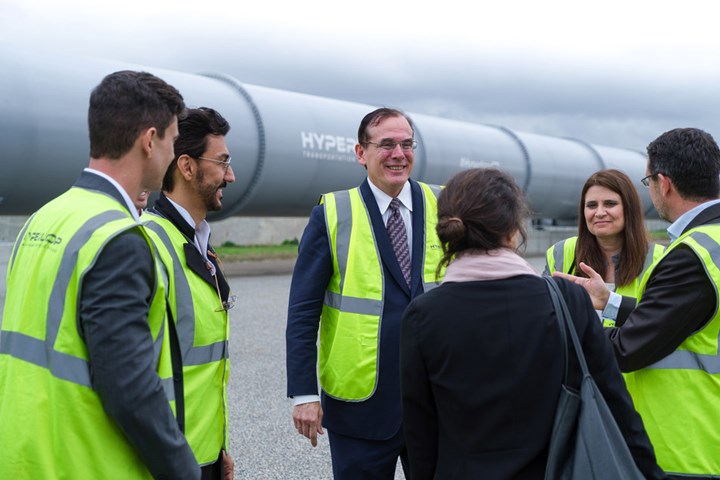
USDOT officials visit HyperloopTT’s research facility in Toulouse, France. Source | Hyperloop Transportation Technologies
The company that appears to be the furthest down the commercialization path is HyperloopTT, which expects to begin testing humans in its pods as soon as 2020. The company’s work has attracted the attention of the U.S. Department of Transportation (USDOT, Washington, D.C.), which visited the company’s research facilities in Toulouse, France in June 2019. USDOT officials were reportedly able to see the company’s full-scale track system as it undergoes optimization and integration prior to the construction of a 10-kilometer track in Abu Dhabi, which HyperloopTT says is the first phase of development aimed at creating a commercial Hyperloop network across the Emirates.
The company presented to USDOT and the European Commission (Brussels, Belgium) a technical overview of Hyperloop technology and certification completed by global testing, certification, inspection and training provider TÜV SÜD (Munich, Germany). With tubes assembled and pumps installed at its test facility in Toulouse, France, HyperloopTT says it is now preparing its full-scale passenger capsule for human trials in 2020.
“Not only are we building the only truly full-scale, insured and safety certified system in the world,” says Dirk Ahlborn, CEO of Hyperloop Transportation Technologies. “We are advancing our efforts to move the Hyperloop forward by sharing our technological experience and our perspective on regulatory frameworks.”
“We are moving ever closer to the moment when we will move people in the Hyperloop for the first time,” adds Bibop Gresta, chairman of Hyperloop TT. “And by sharing our insights with our government colleagues in the United States and Europe, we are furthering our goal of creating the safest and most efficient form of transportation the world has ever seen.”
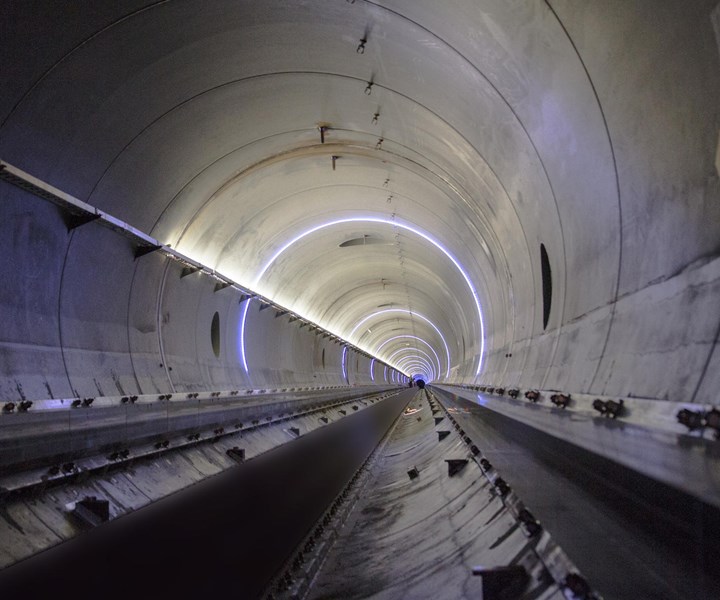
Interior of Virgin Hyperloop One’s DevLoop test track in Nevada. Source | Virgin Hyperloop One
Analogous to the way Hyperloop is meant to gradually accelerate to aircraft speeds, the vision for Hyperloop seems to be gaining momentum. Of course, Hyperloop has its detractors — concerns are continually raised about cost, safety of the tubes, problems with thermal expansion and susceptibility to terrorist attack, to name a few. Nevertheless, the original open-source idea of Hyperloop, meant to spark innovation, competition and collaboration, seems to have achieved its goal — there is, clearly, a global, multi-company effort to tackle the challenges Hyperloop poses, and to make the dream reality.
Richard Branson, founder of the Virgin Group, believes “we could see a Hyperloop in the U.S. in years, not decades.” If that’s the case and Hyperloop does reach full speed, the composites industry will most certainly continue to be involved to support it.
Related Content
MFFD thermoplastic floor beams — OOA consolidation for next-gen TPC aerostructures
GKN Fokker and Mikrosam develop AFP for the Multifunctional Fuselage Demonstrator’s floor beams and OOA consolidation of 6-meter spars for TPC rudders, elevators and tails.
Read MoreGKN Aerospace, Joby Aviation sign aerostructures agreement
GKN Aerospace will manufacture thermoplastic composite flight control surfaces for Joby’s all-electric, four-passenger, composites-intensive ride-sharing aircraft.
Read MoreComposite resins price change report
CW’s running summary of resin price change announcements from major material suppliers that serve the composites manufacturing industry.
Read MoreCOMPINNOV TP2 project promotes use of thermoplastics in aerospace
Completed in 2023, COMPINNOV TP2 explored thermoplastic composites, enhancing the understanding between prepregs and production methods to foster the potential for French aerospace innovation.
Read MoreRead Next
Episode 20: Delft Hyperloop
Thymo Vlot and Ze Soengas of Delft Hyperloop and John Jackson of TenCate Advanced Composites discuss Delft’s entry in the SpaceX Hyperloop competition.
Read MoreAll-recycled, needle-punched nonwoven CFRP slashes carbon footprint of Formula 2 seat
Dallara and Tenowo collaborate to produce a race-ready Formula 2 seat using recycled carbon fiber, reducing CO2 emissions by 97.5% compared to virgin materials.
Read MoreDeveloping bonded composite repair for ships, offshore units
Bureau Veritas and industry partners issue guidelines and pave the way for certification via StrengthBond Offshore project.
Read More




















